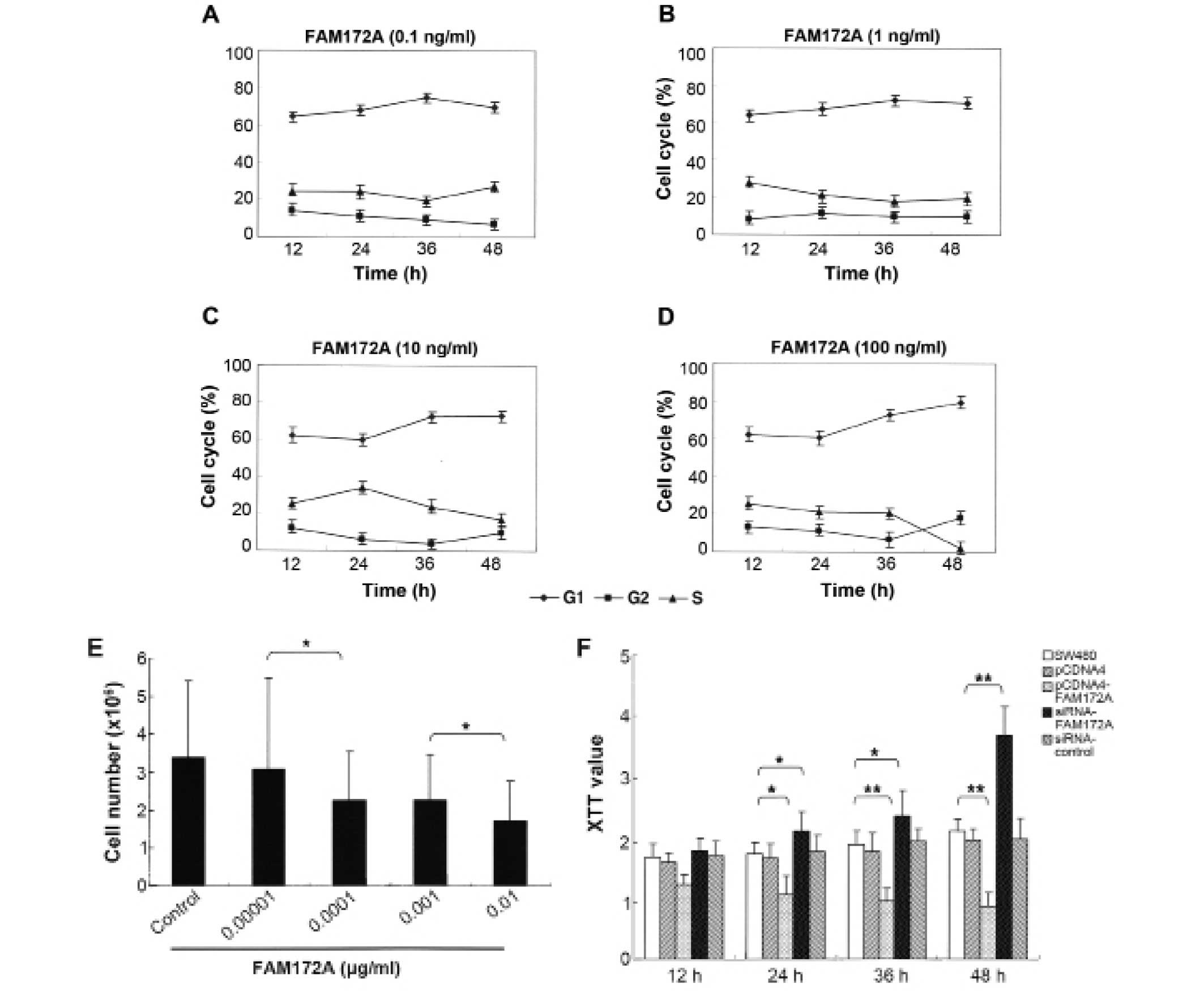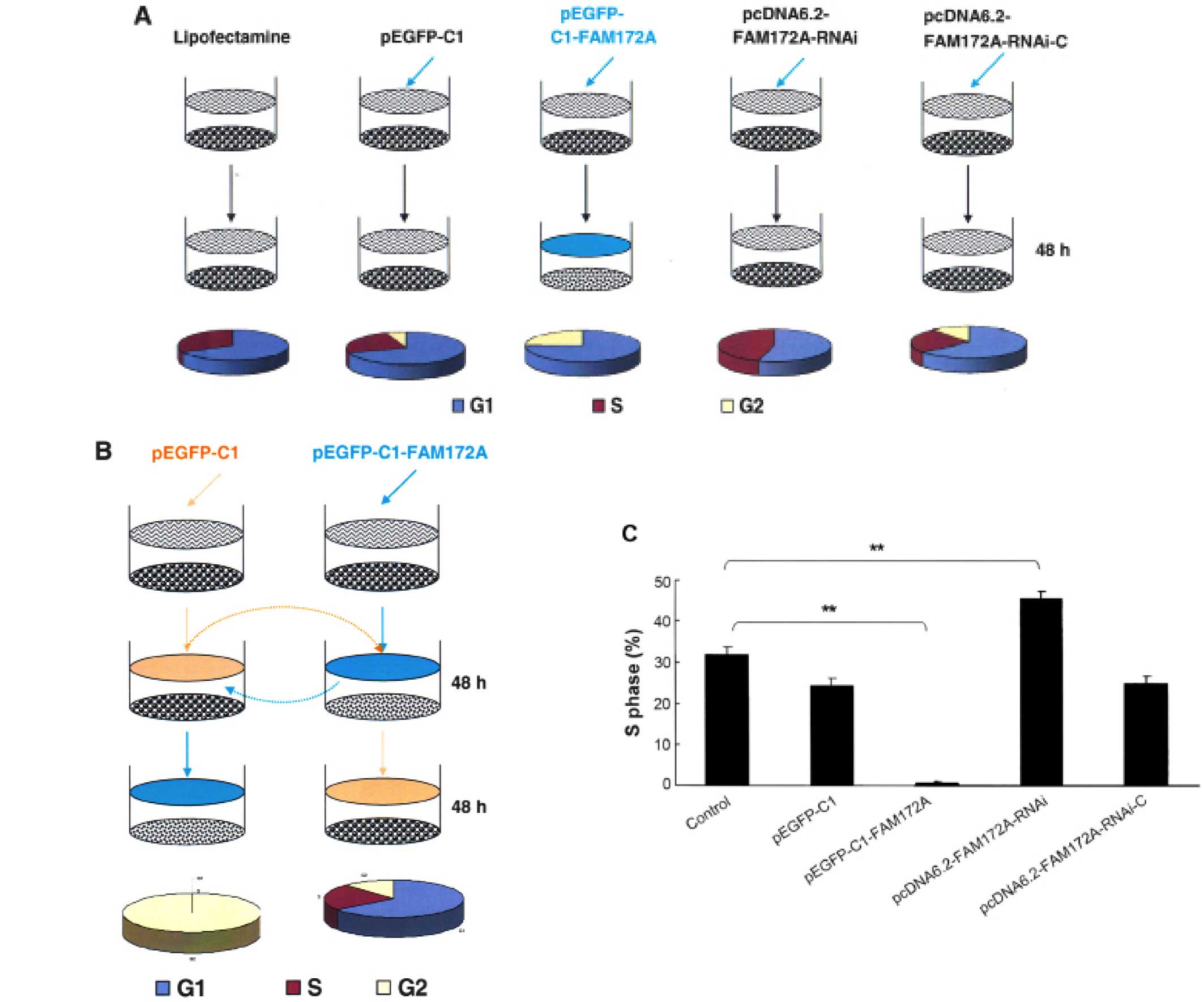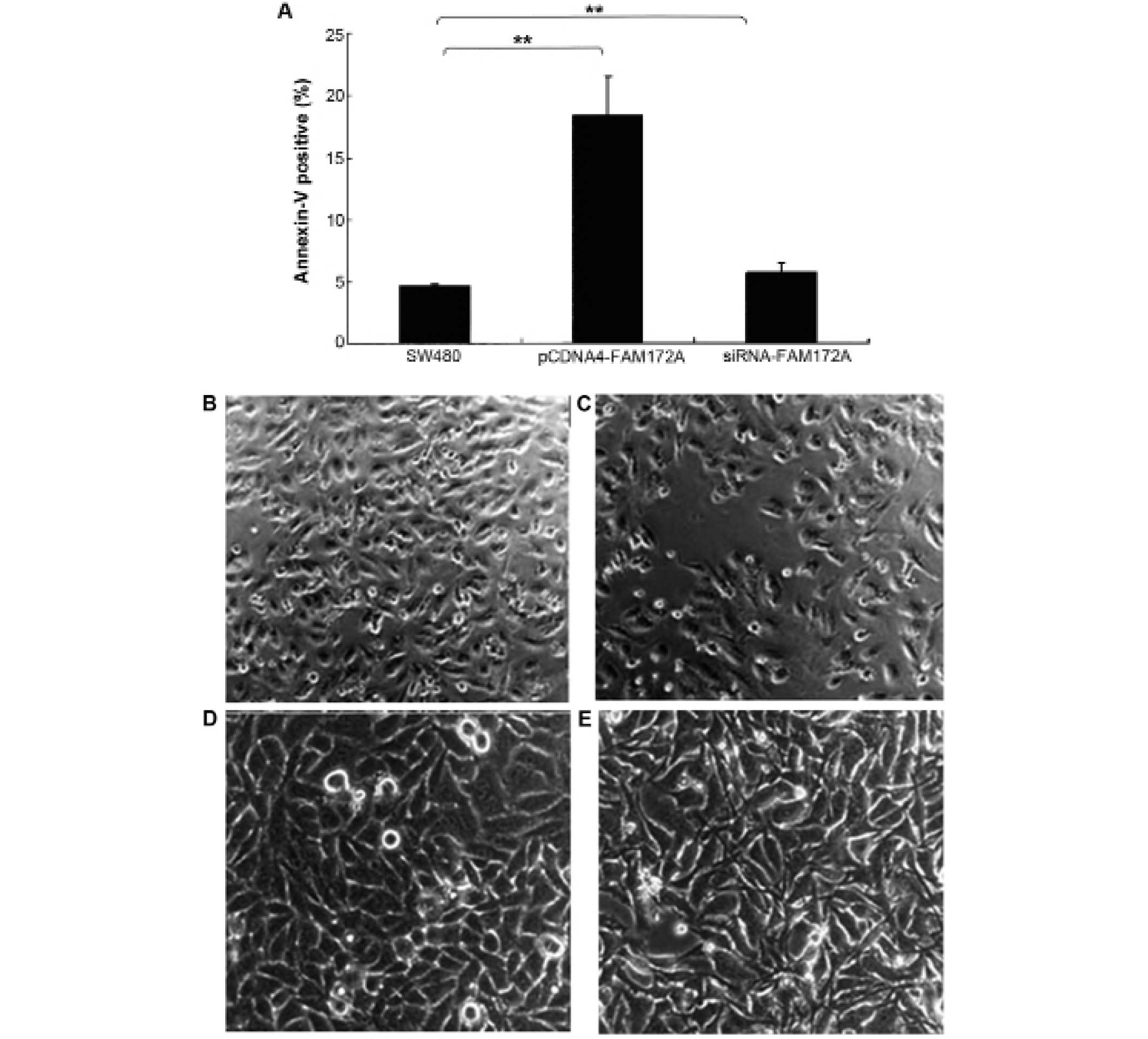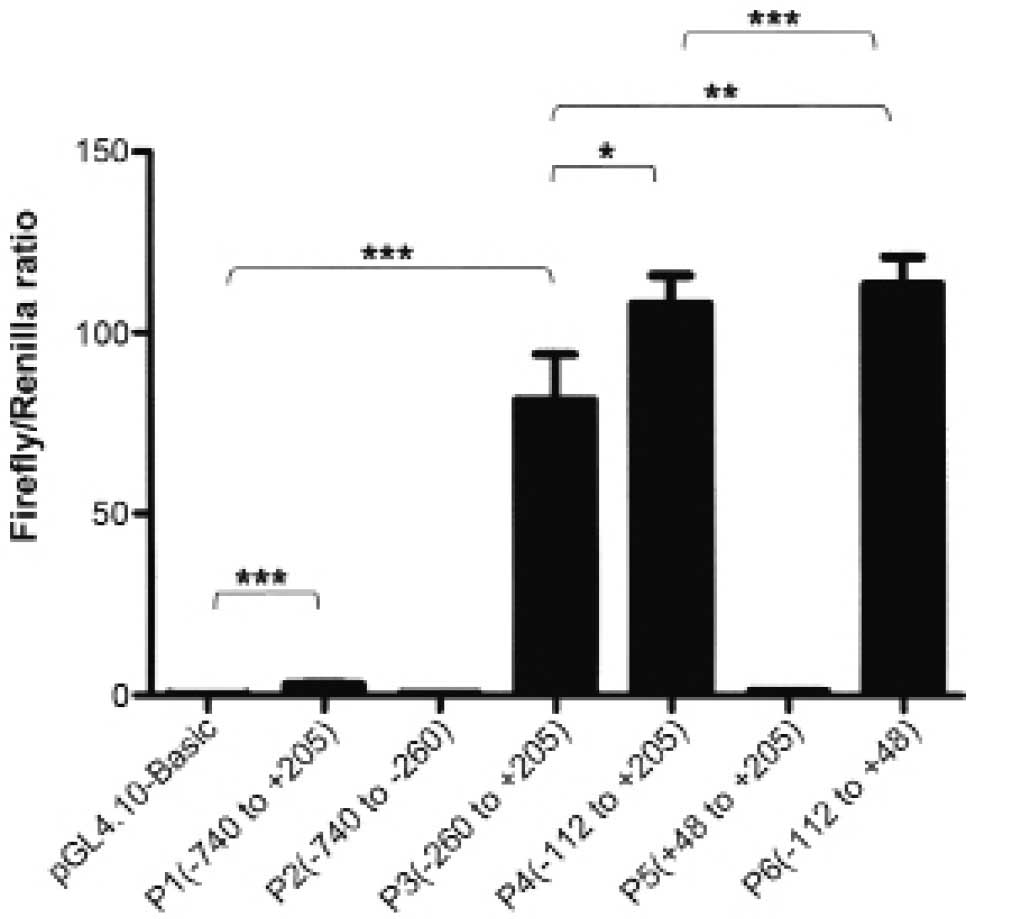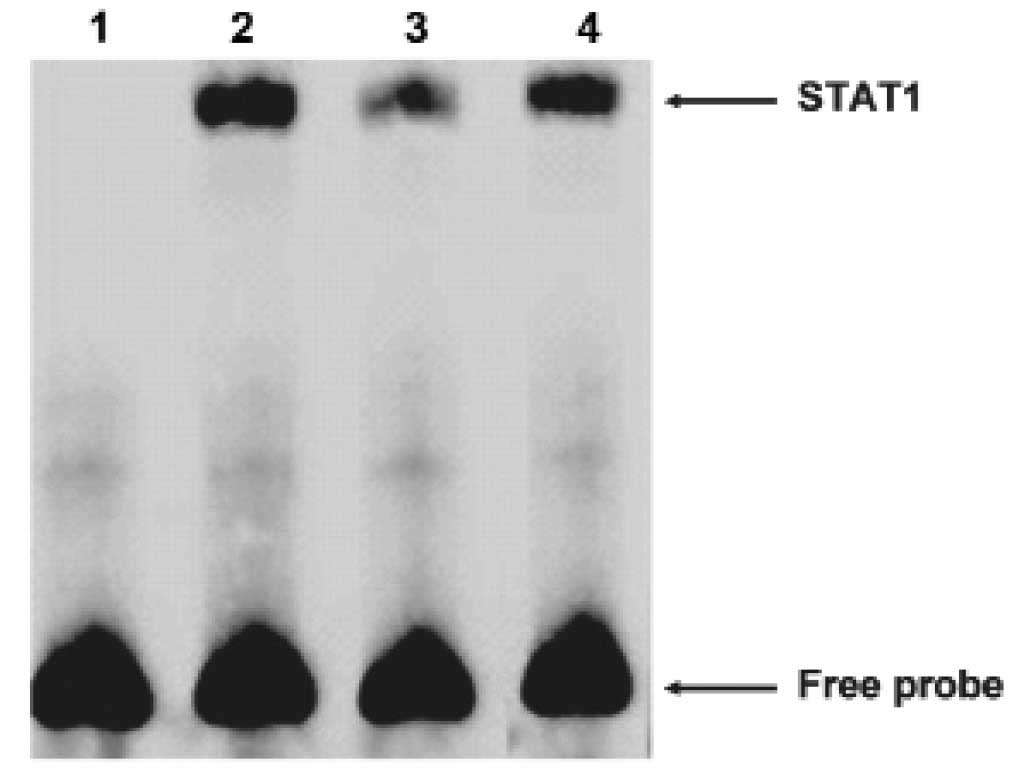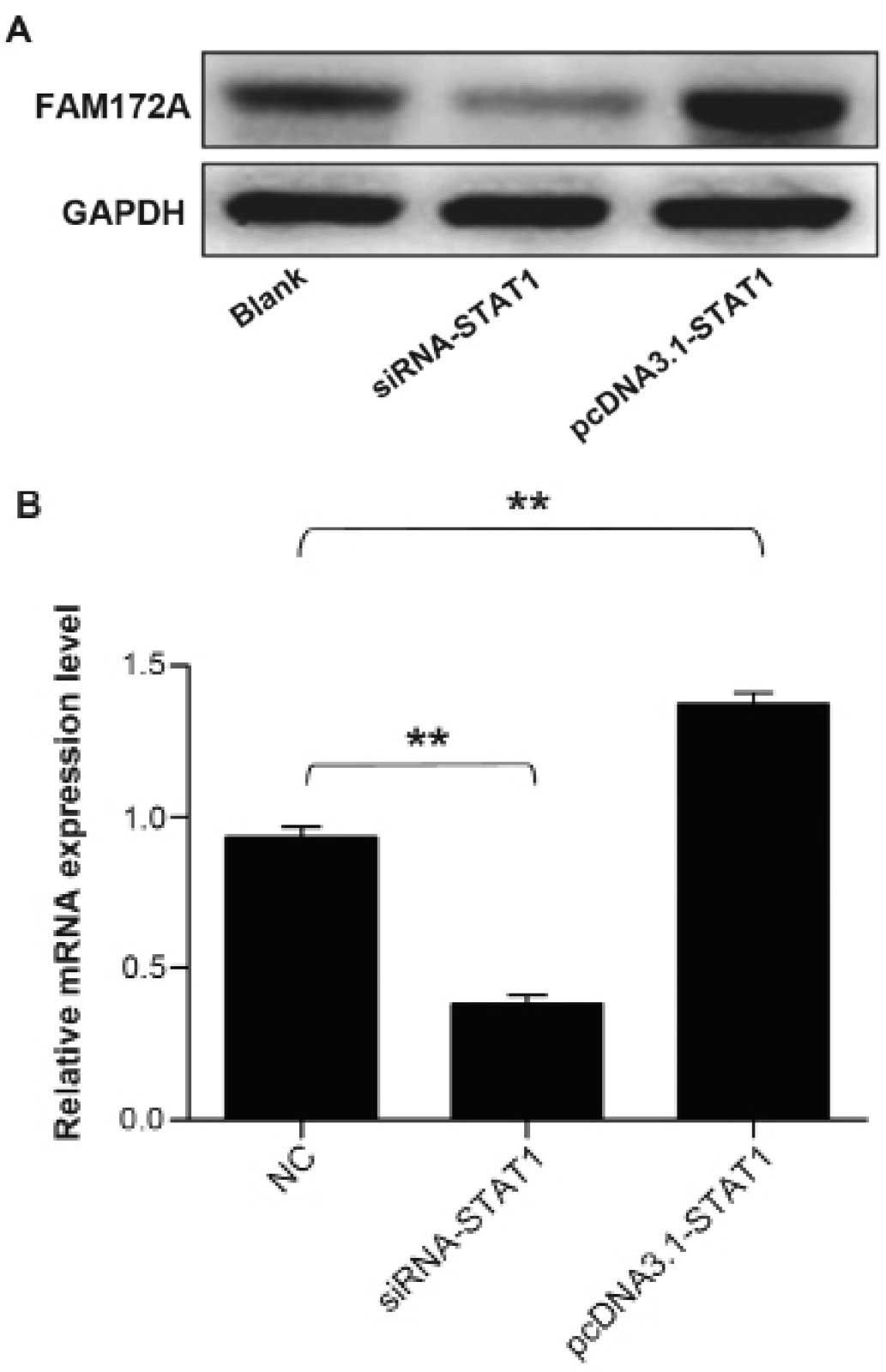FAM172A modulates apoptosis and proliferation of colon cancer cells via STAT1 binding to its promoter
Retraction in: /10.3892/or.2023.8545
- Authors:
- Published online on: December 10, 2015 https://doi.org/10.3892/or.2015.4485
- Pages: 1273-1280
-
Copyright: © Qian et al. This is an open access article distributed under the terms of Creative Commons Attribution License.
Abstract
Introduction
In our previous studies, a functionally unknown gene FAM172A, the family with sequence similarity 172, member A, was identified. Bioinformatics analysis demonstrated that FAM172A (C5orf21, NM_032042.5) contains an open reading frame composed of 1251 nucleotides encoding a protein comprised of 416 amino acids and an Arb2 conserved domain located in gene sequence. Online software CELLO 2.5 (http://cello.life.nctu.edu.tw/) to forcast the subcellular location of the human protein (1), was indicative of localization in the nucleus and/or cytoplasm of human FAM172A protein.
FAM172A was first identified in human aortic endothelial cells, THP-1-derived macrophages, and human aortic smooth muscle cells at the translation level through western blotting (2,3). Feng et al found that FAM172A was notably downregulated among hepatocellular carcinoma or cirrhotic patients. It indicated that FAM172A might be a novel anticancer gene, which enphasizes a crucial role in the control of cell cycle and proliferation of tumor cells (4,5).
STAT1, signaling transducer and transcription activator 1, belongs to the STAT protein family. This protein, activated by ligands including interferon-α, PDGF, and IL6, mediates the expression of various genes, which is considered to be crucial for cell activity in response to pathogens and cell stimuli (6). STAT-proteins are activated by tyrosine phosphorylation, usually by JAK kinases. They dimerize, translocate to the nucleus and activate their specific target genes (7–9). STAT1 is required for apoptosis induced by ischemia in cardiac myocytes and by tumor necrosis factor, oxysterols, and DNA damage (10,11). As an important transcription factor, STAT1 may exert an essential role in the expression of FAM172A.
We have found that FAM172A protein expressed moderately in normal tissue, but decreased significantly in colorectal cancer tissue (4). However, the functions of FAM172A on colon cancer cells are unknown, and the regulatory mechanism of its expression remains unclear. In the current study, our results demonstrated that FAM172A inhibited proliferation and promoted apoptosis or differentiation of colon cancer cells. In addition, we cloned the functional promoter variants in FAM172A and presented that the DNA fragment from −112 and +48 of the FAM172A promoter is crucial for its transcription in LoVo cells. Above all, we elaborated the interaction between transcription factors STAT1 and FAM172A promoter in regulating expression of FAM172A. These findings contribute to clarification of the regulatory mechanisms of FAM172A transcription and to comprehend the functions of FAM172A.
Materials and methods
Cell culture
Human LoVo and SW480 cells were obtained from The General Hospital of People's Liberation Army (Beijing, China). Cells were cultured in a 5% Co2-humidified atmosphere using DMEM medium containing 10% fetal bovine serum (FBS) at 37°C.
Genomic DNA preparation and construction of plasmids
Genomic DNA and cDNA were amplified and sequenced as previously described (12). Genomic DNA was prepared from LoVo cells using a genomic DNA Purification kit (Promega, Madison, WI, USA). DNA fragments of FAM172A [P1 (−740 to +205), P2 (−740 to −260), P3 (−260 to +205), P4 (−112 to +205), P5 (+48 to +205) and P6 (−112 to +48)] upstream of the transcription initiation site were cloned into a pGL4.10 Basic vector with the restriction sites of XholI and EcoRV (Promega). The followings were PCR primers: P1 sense, 5′-CTCGAGTTGCAAAGTACAAACAGTGTG-3′; P2 antisense, 5′-GATATCCAGACTTTACCCTGTCCATTC-3′; P3 sense, 5′-CTCGAGACACACTCTGAGTAGCGGAG-3′; P4 sense, 5′-CTCGAGAGTGCATAAGAGAACTACACTTAATTC-3′; P5 sense, 5′-CTCGAGAGTGCAACTCGAACTTGGTC-3′; P6 antisense, 5′-GATATCTCCGGGGTCTTCAGGAG-3′; P1 antisense, 5′-GATATCCAAACGGCAGTCCTACCTG-3′. The STAT1 expression plasmid was amplified from STAT1 mRNA (PubMed: NM_007315.3) using the upstream primer (5′-GATATCATGTCTCAGTGGTACGAACTTCAGC-3′) and the downstream primer (5′-GGATCCTACTGTGTTCATCATACTGTCGAAT-3′) inserted into pcDNA3.1/myc-His (−) plasmid with restriction sites EcoRV and BamHI.
Dual-luciferase reporter assay
The method of Luciferase reporter assay was previously described (13). LoVo cells were cultured in a 48-well plates in advance and transfected with 0.23 μg of FAM172A promoter plasmids and 0.02 μg of endogenous control phRL-TK plasmids using jetPRIME™ (Polyplus Transfection, Illkirch, France) in accordance with the manufacturer's protocol. The medium was changed 4 h after transfection, then continued for approximately 24 h. Afterwards, cells were collected and lysed in 70 μl of passive lysis buffer. Luciferase reporter assay was implemented with a dual-luciferase reporter assay system (Promega) and measured using a Veritas Microplate Luminometer (Turner BioSystems, USA). The transfections were conducted in triplicate, and the activities of promoter was recorded as Firefly/Renilla ratio using mean ± SEM of three independent experiments. For STAT1 responses, 0.11 μg of FAM172A promoter plasmids, 0.03 μg of phRL-TK plasmids as internal control and 0.11 μg of pcDNA3.1 (−)-STAT1 plasmids were co-transfected into LoVo cells.
Cell counting and cell cycle assay
Colon cancer cells were added with diverse concentrations of FAM172A recombinant proteins (0, 0.1, 1.0, 10 and 100 ng/ml). Then, cells were trypsinized and washed lightly in PBS followed by fixation for 30 min in ice-cold 70% ethanol. Subsequently, cells were harvested and then stained with 7-AAD (5 mg/ml) for 30 min. The group treated by PBS was applied to the controls. Cell cycle was determined by flow cytometer (BD Biosciences, San Diego, CA, USA). The results were analysed with Modifit software.
Determination of apoptosis
Annexin V-FLUOS (Biolegend) staining was performed on the cells and analyzed using a fluorescence-activated cell sorting (FACS) following the described protocol (14). Cells (3×105) were cultured onto dishes for 48 h, and subsequently washed at 4°C for 30 min with PBS and then incubated at 4°C for 3 h with Annexin V-FLUOS staining solution (Roche Diagnostics, Indianapolis, IN, USA). Afterwards, gels were washed 4 times in PBS at 4°C and fixed with 1% paraformaldehyde (Sigma-Aldrich) at room temperature for 15 min. The total number of cells were identified separately by FACS technique. Apoptosis was verified by detection of activated caspases (12).
Chromatin immunoprecipitation (ChIP)
The process for ChIP was previously clarified (15,16). LoVo cells (1×106) were cultured for this experiment. Immunoprecipitation was performed overnight at 4°C with 5 μg of anti-STAT1 (Cell Signaling Technology inc., Danvers, MA, USA) or negative control, normal anti-IgG antibody or positive control, anti-acetyl histone H3 antibody and 20 μl of protein A agarose beads. The immunoprecipitated complex was washed multiple times, and then DNA-antibody-protein complex was detached from the beads. Followed by decross-link incubation, the RNA and protein were removed by RNAse and proteinase K, and a quantitative real-time PCR was carried out to amplify the eluted DNA with specific primers for the STAT1 binding site. A 1% agarose gel was used to separate the PCR products.
Electrophoretic mobility shift assay (EMSA)
The EMSA annlysis was condocted as previously described (17). Probes for EMSA were synthesized by a biotin label at the 3′ end (Invitrogen, Shanghai, China). To prepare Nuclear extracts from LoVo cells, a Nuclear Extraction kit (Pierce, Rockford, IL, USA) was utilized. Protein concentration was quantitated by BCA protein assay kit (Pierce). EMSA assays were done using LightShift chemiluminescence EMSA kit (Pierce). DNA-protein binding reactions were executed in a 20 μl volume using 3 μg of nuclear extract in a binding buffer containing different volumes of 50% glycerol, 100 mM MgCl2, and 0.02 mM EDTA. The complexes were separated using 6.5% non-denaturing polyacrylamide gels. To analyze the supershift, additional 5 μg anti-STAT1 antibody was added 30 min prior to the addition of complexes.
Western blot analysis and polyclonal antibody
Preparation and generation of FAM172A recombinant protein was previously described (2). Then protein was boiled with 5X SDS gel loading buffer. Equal amounts of sample were subjected to 10% SDS-PAGE electrophoresis, transferred to PVDF membrane (Millipore, Billerica, MA, USA), and incubated with specific antibodies, respectively, followed by secondary antibodies IgG. Expression of GAPDH was considered as an internal control. The band intensities of protein were quantitated using the GE Typhoon Trio (GE Healthcare, Piscataway, NJ, USA).
RNA isolation and real-time PCR
We used Total RNA kit I (Promega) to extract total RNA from cultured cells. Extracted RNA was quantified by spectrophotometry. The 0.1 μg of RNA was reversely transcribed by PrimeScript™ RT reagent kit (Takara, Otsu, Japan). Power SYBR® Green PCR Master Mix was performed for real-time PCR using an ABI Prism 7500 (USA). β-actin was considered as an internal control. The specific primers of FAM172A were as follows: sense, 5′-cgactggcgaactggaag-3′; antisense, 5′-gagctcaaggaaatagacatcaatc-3′.
Statistical analysis
The results are presented as means ± SEM. For statistical analysis, the two-tailed Student's t-test or one-way analysis of variance (ANOVA) was done to compare the differences of means using GraphPad Prism 5 or SPSS 20 software. p-value <0.05 was set as statistically significant. All experiments were repeated three separate times unless stated otherwise.
Results
FAM172A inhibits proliferation of colon cancer cells
To determine the influence of FAM172A on the cell cycle, SW480 colon cancer cells were co-cultured with different concentrations of FAM172A recombinant protein. We found that the percentage of cells in S phase and the total number of colon cancer cells decreased in a dose-dependent manner (Fig. 1A–E). Morever, when at the highest concentration (0.01 μg/ml), the percentage of colon cancer cells in S phase reduced to 3.18%. These results demonstrated that FAM172A could significantly suppress the proliferation of colon cancer cells, especially at a concentration >0.01 μg/ml.
Using XTT proliferation assay we found that FAM172A significantly inhibited cell growth of SW480 cells compared to control group at each time point (p<0.01) (Fig. 1F). The cells transfected with FAM172A were arrested at G1/S phase. Following transfection with different vectors for 48 h, the S-phase of SW480 transfected with pEGFP-C1, pEGFP-C1-FAM172A, pcDNA6.2-FAM172A shRNA and pcDNA6.2-negative were 31.73, 24.32, 0.18, 45.42 and 24.85%, respectively (Fig. 2A). After changing the culture supernatant of cells, the influence of FAM172A on the cell cycle was investigated (Fig. 2B). After incubation for 48 h, the S-phase of SW480 cells was 40.1% (Fig. 2B). However, when SW480 cells were cultured for an additional 48 h with the culture supernatant of SW480 cells transfected with pEGFP-C1- FAM172A, the S-phase was undetectable.
SW480 cells transfected with pEGFP-C1- FAM172A were cultured for 48 h, and then further cultured for another 48 h with interchanged culture supernatant from SW480 cells cultured for 48 h, but we found that the S-phase was unchanged. Compared with the control cells, the cell cycles of the cells transfected with pEGFP-C1-FAM172A were arrested at G1/S phase (p<0.05). The results of pEGFP-C1-transfected group was the same as the pcDNA6.2-RNAi-c-transfected group, and the cells of the two groups were lower in number than the control cells (p>0.05). Furthermore, the S-phase of pcDNA6.2-FAM172A-RNAi-3-transfected group was higher than the other groups (p<0.05) (Fig. 2C).
FAM172A promotes apoptosis and differentiation of colon cancer cells
The effect of FAM172A on apoptosis was assessed in colon cancer cells by flow cytometry. Upregulation of FAM172A in SW480 cells induced increase of apoptosis (p<0.01). Moreover, SW480 cells treated with shRNA of FAM172A suppressed apoptosis significantly (p<0.01) (Fig. 3A). FAM172A recombinant protein caused differentiation (Fig. 3C, magnification ×100; and 3E, magnification ×400) of SW480 cells compared with control (Fig. 3B, magnification ×100; and 3D, magnification ×400).
Identification and analysis of FAM172A promoter
In order to identify the FAM172A promoter, we obtained the FAM172A gene mRNA and analyzed and predicted the transcription start sites based on NCBI database and UCSC genome Browser (http://genome.ucsc.edu/). Then the genomic DNA fragment from −740 bp to +205 bp in the predicted promoter of FAM172A was amplified from LoVo cells. The putative FAM172A promoter region was inserted into a pGL4.10 Basic vector with the restriction sites XholI and EcoRV. pGL4.10-FAM172A promoter was named P1 and used for further shortened promoter plasmids as the template. After transfection for 24 h, Luciferase reporter assay was carried out. The results were recorded as Firefly/Renilla ratio. Compared with pGL4.10 Basic, P1 had ~40-fold luciferase activity, which indicated that the putative FAM172A promoter was active in the LoVo cells. Then, we studied the minimal FAM172A promoter. Five recombinants plasmids P2, P3, P4, P5 and P6 were constructed, respectively by sequentially truncating P1 plasmid. Subsequently, luciferase assays were carried out as above. The luciferase activity results are shown in Fig. 4. The serial truncation analysis suggested that P6, −112 to +48, contained the essential sequences for transcriptional activity.
Prediction of transcription factor and its binding sites
We predicted possible transcription factors by searching TFSEARCH (http://www.cbrc.jp/research/db/TFSEARCH.html) and GeneCards (http://www.genecards.org/). Based on our analysis, one major common transcription factor with the highest score, STAT1, was within the minimum promoter. The STAT1 binding site was between −68 and −58 within the mimimal promoter region (−112 to +48).
Specific binding of STAT1 transcription factors to the functional promoter
In order to investigate whether STAT1 could bind to FAM172A promoter in vivo, chromatin immunoprecipitation (ChIP) was performed followed by the PCR assay to amplify the region between −112 and +48. These results demonstrated that the binding bite of STAT1 was presented on P6 compared with IgG-precipitated controls. This revealed that STAT1 could specifically bind to the FAM172A promoter (Fig. 5).
Then we carried out electrophoretic mobility shift assays (EMSA) to explore whether STAT1 could bind the FAM172A promoter. The oligonucleotide contained sequences which matched a consensus binding site for STAT1 was chose for EMSA. The nuclear extracts from the LoVo cells revealed strong binding to a labeled probe embracing an STAT1 binding sites. We then conducted competition experiments with unlabeled probes. DNA-protein complexes were specific, as demonstrated by the fact that it could be completely out-competed by a 100-fold excess of unlabeled probe (Fig. 6). These results suggested that STAT1 was able to bind to the FAM172A minimum promoter. As shown above, these results revealed that STAT1 could specifically bind to the FAM172A promoter.
Upregulation of the expression of FAM172A by STAT1 transcription factor
To address whether STAT1 transcription factor could facilitate the expression of FAM172A, we performed western blot analysis together with quantitative real-time PCR to validate the upregulation of FAM172A. The protein samples and total RNA were extracted from cultured LoVo cells transfected with STAT1 gene overexpression plasmid and siRNA. The results demonstrated that the mRNA and protein expression level of FAM172A increased prominently induced by STAT1, which infered that STAT1 could promote the expression of FAM172A. The results are presentrd in Fig. 7.
Discussion
Our previous study (4) found that FAM172A significantly decreased in colorectal cancer tissues, but its functions were unknown and few relevant studies on FAM172A in colorectal cancer were reported. In this investigation, we explored the functions of FAM172A gene and the mechanism of its transcriptional regulation. Firstly, XTT assays showed that FAM172A was able to significantly inhibit proliferation of colon cancer cells. Subsequently, we evaluated the effect of FAM172A on the cell cycle and apoptosis. Our results elaborated that FAM172A could promote apoptosis of colon cancer cells and might be involved in G1/S arrest. In summary, we considered that FAM172A might be an important target gene for anti-colon cancer therapy in the future. Then the regulation of expression of FAM172A was studied because transcription process is one of the most important factors. A putative promoter of FAM172A, a region ~945 bp upstream of transcription start site, was cloned in a reporter vector. Then truncated promoters were constructed as indicated above. These promoters were analyzed using dual-luciferase reporter assay system in LoVo cells. The fragment P6 had the highest promoter activity, which indicated P6 possessed the essential sequences for transcription activity and might be a minimum promoter region. This minimum promoter fragment, from −112 bp to +48 bp, was verified to drive the expression of FAM172A.
In addition, the major cis-acting element STAT1 was present in this minimum promoter region. Further studies showed that STAT1 could bind to the minimum FAM172A promoter. We considered that STAT1 might affect the expression of FAM172A. After co-transfection of STAT1 over expression plasmid or siRNA with minimum promoter in vitro, the results revealed that STAT1 strongly increased the transcriptional activity of FAM172A minimum promoter.
STAT proteins emphasize a vital role in signal-transduction pathways activated by cytokines (18,19). The JAK-STAT pathway is essential for converting cytokine signals into gene expression programs and then mediates the cell proliferation and differentiation (12,20,21). As a transcription factor, we predicted that STAT1 could affect the FAM172A expression. After transfected with overexpression plasmid and siRNA of STAT1, the western blot analysis and real-time PCR demonstrated that FAM172A was significantly upregulated by STAT1 compared to control groups. The result indicated that STAT1 could enhance the activity of FAM172A promoter, prompting its transcription, thus upregulating the expression of FAM172A.
In conclusion, this study identified the minimum FAM172A promoter and demonstrated that FAM172A is upregulated by STAT1 transcription factor. We also elucidated the regulatory mechanisms of FAM172A transcription. This will add to better understanding of the functions of FAM172A.
In conclusion, FAM172A modulated apoptosis and the proliferation process of colon cancer cells. We will conduct further studies to explore the functions of FAM172A for the biological treatment of colorectal cancer.
Acknowledgments
This study was supported by grants from the National Natural Science Foundation of China (81172383), Guangdong Natural Science Foundation (2014A030313324) and the Key Clinical Specialty Discipline Construction Program.
References
|
Yu CS, Chen YC, Lu CH and Hwang JK: Prediction of protein subcellular localization. Proteins. 64:643–651. 2006. View Article : Google Scholar : PubMed/NCBI | |
|
Li L, Dong X, Leong MC, Zhou W, Yang Z, Chen F, Bao Y, Jia W and Hu R: Identification of the novel protein FAM172A, and its up-regulation by high glucose in human aortic smooth muscle cells. Int J Mol Med. 26:483–490. 2010.PubMed/NCBI | |
|
Li LX, Tao Z, Dong XH, Liang WC, Yang Zh, Mou B, Bao YQ, Wang C, Jia WP and Hu RM: Molecular cloning of a novel gene, C5orf21 gene and its roles in diabetic macroangiopathy. Zhonghua Yi Xue Za Zhi. 89:2574–2577. 2009.in Chinese. | |
|
Feng Z, Li H, Liu S, Cheng J, Xiang G and Zhang J: FAM172A induces S phase arrest of HepG2 cells via Notch 3. Oncol Rep. 29:1154–1160. 2013.PubMed/NCBI | |
|
Ehebauer M, Hayward P and Arias AM: Notch, a universal arbiter of cell fate decisions. Science. 314:1414–1415. 2006. View Article : Google Scholar : PubMed/NCBI | |
|
DeVries TA, Kalkofen RL, Matassa AA and Reyland ME: Protein kinase Cdelta regulates apoptosis via activation of STAT1. J Biol Chem. 279:45603–45612. 2004. View Article : Google Scholar : PubMed/NCBI | |
|
Heim MH: The Jak-STAT pathway: Cytokine signalling from the receptor to the nucleus. J Recept Signal Transduct Res. 19:75–120. 1999. View Article : Google Scholar : PubMed/NCBI | |
|
Rawlings JS, Rosler KM and Harrison DA: The JAK/STAT signaling pathway. J Cell Sci. 117:1281–1283. 2004. View Article : Google Scholar : PubMed/NCBI | |
|
Kisseleva T, Bhattacharya S, Braunstein J and Schindler CW: Signaling through the JAK/STAT pathway, recent advances and future challenges. Gene. 285:1–24. 2002. View Article : Google Scholar : PubMed/NCBI | |
|
Agrawal S, Agarwal ML, Chatterjee-Kishore M, Stark GR and Chisolm GM: Stat1-dependent, p53-independent expression of p21(waf1) modulates oxysterol-induced apoptosis. Mol Cell Biol. 22:1981–1992. 2002. View Article : Google Scholar : PubMed/NCBI | |
|
Townsend PA, Scarabelli TM, Davidson SM, Knight RA, Latchman DS and Stephanou A: STAT-1 interacts with p53 to enhance DNA damage-induced apoptosis. J Biol Chem. 279:5811–5820. 2004. View Article : Google Scholar | |
|
Dupuis S, Jouanguy E, Al-Hajjar S, Fieschi C, Al-Mohsen IZ, Al-Jumaah S, Yang K, Chapgier A, Eidenschenk C, Eid P, et al: Impaired response to interferon-alpha/beta and lethal viral disease in human STAT1 deficiency. Nat Genet. 33:388–391. 2003. View Article : Google Scholar : PubMed/NCBI | |
|
Datta M and Bhattacharyya NP: Regulation of RE1 protein silencing transcription factor (REST) expression by HIP1 protein interactor (HIPPI). J Biol Chem. 286:33759–33769. 2011. View Article : Google Scholar : PubMed/NCBI | |
|
Haybaeck J, Obrist P, Schindler CU, Spizzo G and Doppler W: STAT-1 expression in human glioblastoma and peritumoral tissue. Anticancer Res. 27:3829–3835. 2007. | |
|
Das S and Bhattacharyya NP: Transcription regulation of HYPK by Heat Shock Factor 1. PLoS One. 9:e855522014. View Article : Google Scholar : PubMed/NCBI | |
|
Gao X, Wang Q, Li W, Yang B, Song H, Ju W, Liu S and Cheng J: Identification of nucleolar and coiled-body phosphoprotein 1 (NOLC1) minimal promoter regulated by NF-κB and CREB. BMB Rep. 44:70–75. 2011. View Article : Google Scholar : PubMed/NCBI | |
|
Pradhan SA, Rather MI, Tiwari A, Bhat VK and Kumar A: Evidence that TSC2 acts as a transcription factor and binds to and represses the promoter of Epiregulin. Nucleic Acids Res. 42:6243–6255. 2014. View Article : Google Scholar : PubMed/NCBI | |
|
Cheon H, Yang J and Stark GR: The functions of signal transducers and activators of transcriptions 1 and 3 as cytokine-inducible proteins. J Interferon Cytokine Res. 31:33–40. 2011. View Article : Google Scholar : | |
|
Chapgier A, Boisson-Dupuis S, Jouanguy E, Vogt G, Feinberg J, Prochnicka-Chalufour A, Casrouge A, Yang K, Soudais C, Fieschi C, et al: Novel STAT1 alleles in otherwise healthy patients with mycobacterial disease. PLoS Genet. 2:e1312006. View Article : Google Scholar : PubMed/NCBI | |
|
Stark GR and Darnell JE Jr: The JAK-STAT pathway at twenty. Immunity. 36:503–514. 2012. View Article : Google Scholar : PubMed/NCBI | |
|
Pfitzner E, Kliem S, Baus D and Litterst CM: The role of STATs in inflammation and inflammatory diseases. Curr Pharm Des. 10:2839–2850. 2004. View Article : Google Scholar : PubMed/NCBI |



